- home
- BAKERECIPES
BakeRecipes
Bringing real baking into your home with deliciously simple recipes.

Prep 10minBake 15-18minMakes about 9
Scones are what I whip up if time is short – they are simple, fast and everyone loves them. The secret to the lightness of these scones is the surprising combination of lemonade and cream (instead of milk) – it may seem a little odd but, believe me, it works!
Ingredients
450g (3 cups) self-raising flour, plus extra, to dustPinch of Salt
80g butter, cubed, softened slightly
125ml (½ cup) lemonade, at room temperature
185ml (¾ cup) pouring cream, plus extra to glaze
Berry jam and whipped cream, to serve
Method
- Preheat the oven to 200°C. Lightly grease a baking tray with butter and then lightly dust with flour, shaking off any excess.
- Put the flour and salt in a medium bowl. Use your fingertips to rub in the butter until the mixture resembles fine breadcrumbs and the butter is evenly incorporated. Make a well in the centre.
- Combine the cream and lemonade, add to the flour mixture and use a flat-bladed knife to mix with a cutting action until the dough comes together in clumps.
- Use lightly floured hands to bring the dough together – it will be soft, but not sticky. Place on a lightly floured surface and knead lightly and briefly (only about 6 times) to bring it together in a smooth ball.
- Use the palm of your hand to flatten the dough out to about 2cm thick. Using a floured 6 cm round cutter, cut the dough into 9 rounds. Gathering the offcuts and, without over handling, pressing out as before, when necessary. Place on the prepared tray, 1-2cm apart. Use a pastry brush to lightly brush the top of each scone with a little extra cream, then dust with a little extra flour.
- Bake in the middle of the preheated oven for 15-18 minutes, until the scones are lightly golden and cooked through; they are ready if they sound hollow when you tap them on the base. Serve warm or at room temperature, split and topped with jam and cream.
Baker's Tips
- These scones are best eaten on the day they are made.
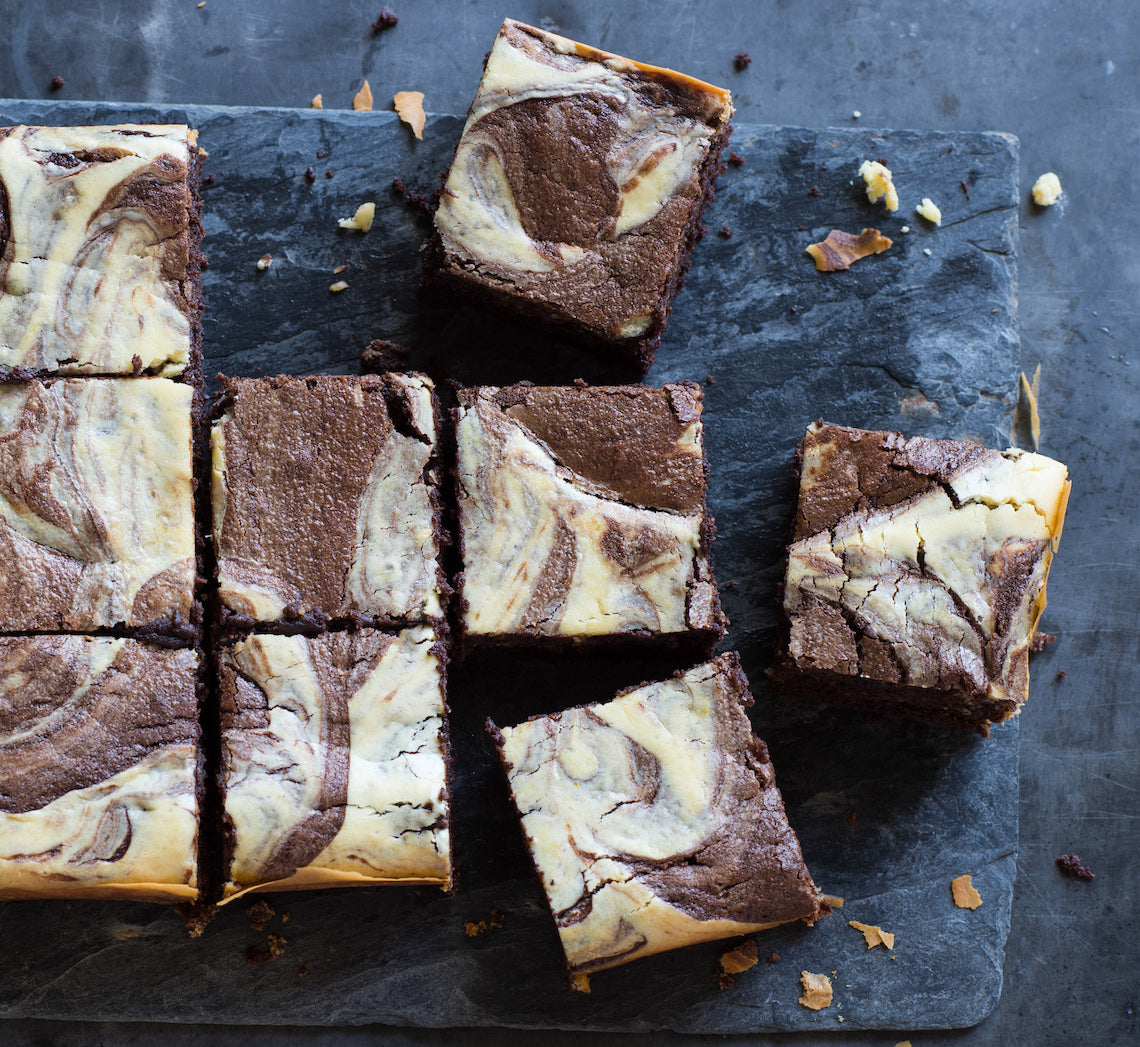
Prep 25min (+ 1hr cooling time)Bake 45-50minMakes about 15
Essentially these fudgy brownies are marbled with an orange-scented cheesecake and they appear far more difficult to make than what they actually are. Perfect with a cuppa or a dollop of cream for dessert these brownies will satisfy any chocolate craving.
Ingredients
Brownie base
Melted butter, to grease250g good-quality dark chocolate (45-54% cocoa), chopped
150g salted butter, cubed
165g (¾ cup) caster sugar
3 eggs, at room temperature, lightly whisked
75g (½ cup) plain flour
30g (¼ cup) cocoa powder
¾ teaspoon baking powder
Cheesecake topping
200g cream cheese, at room temperature30g salted butter, at room temperature
1 tablespoon finely grated orange zest
55g (¼ cup) caster sugar
1 egg yolk, at room temperature
Method
- Preheat oven to 160ºC (140ºC fan-forced). Grease a 16cm x 26cm shallow slice tin with melted butter and line the base and long sides with one piece of baking paper.
- To make the Cheesecake Topping, use an electric mixer to beat the cream cheese, butter and orange rind in a medium bowl until creamy and smooth, scraping down the sides of the bowl when necessary. Add the sugar and beat until well combined. Add the egg yolk and beat well. Set aside.
- To make the Brownie Base, place the dark chocolate and butter in a medium heatproof bowl over a saucepan of gently simmering water (don’t let the base of the bowl touch the water). Stir occasionally until chocolate and butter melt and the mixture is smooth. Remove bowl from saucepan. Add the sugar and eggs and use a balloon whisk or wooden spoon to stir until well combined. Sift together the flour, cocoa powder and baking powder. Add to chocolate mixture and stir until just combined.
- Spoon half the Brownie Base mixture into prepared tin and spread evenly. Drop spoonfuls of almost all the Cheesecake Topping randomly over the brownie mixture. Top with spoonfuls of the remaining brownie mixture and then the remaining topping mixture. Tap the tin on the benchtop to settle the mixture. Use a butter knife or palette knife to swirl the two mixtures together to create a marbled effect and then tap on the bench again if necessary.
- Bake in preheated oven for 45-50 minutes or until moist crumbs cling to a skewer inserted in the centre. Remove from the oven and cool in tin on a wire rack (this will take about 1 hour).
- Carefully remove brownie from the tin using the baking paper to lift it out. Cut into portions to serve.
Baker's Tips
- These brownies will keep in an airtight container in the fridge, for up to 5 days. Serve at room temperature.
This recipe is from Anneka's SBS Food online column, Bakeproof: Easy Chocolate Cakes. CLICK HERE for more Bakeproof recipes.
Photography by Alan Benson.
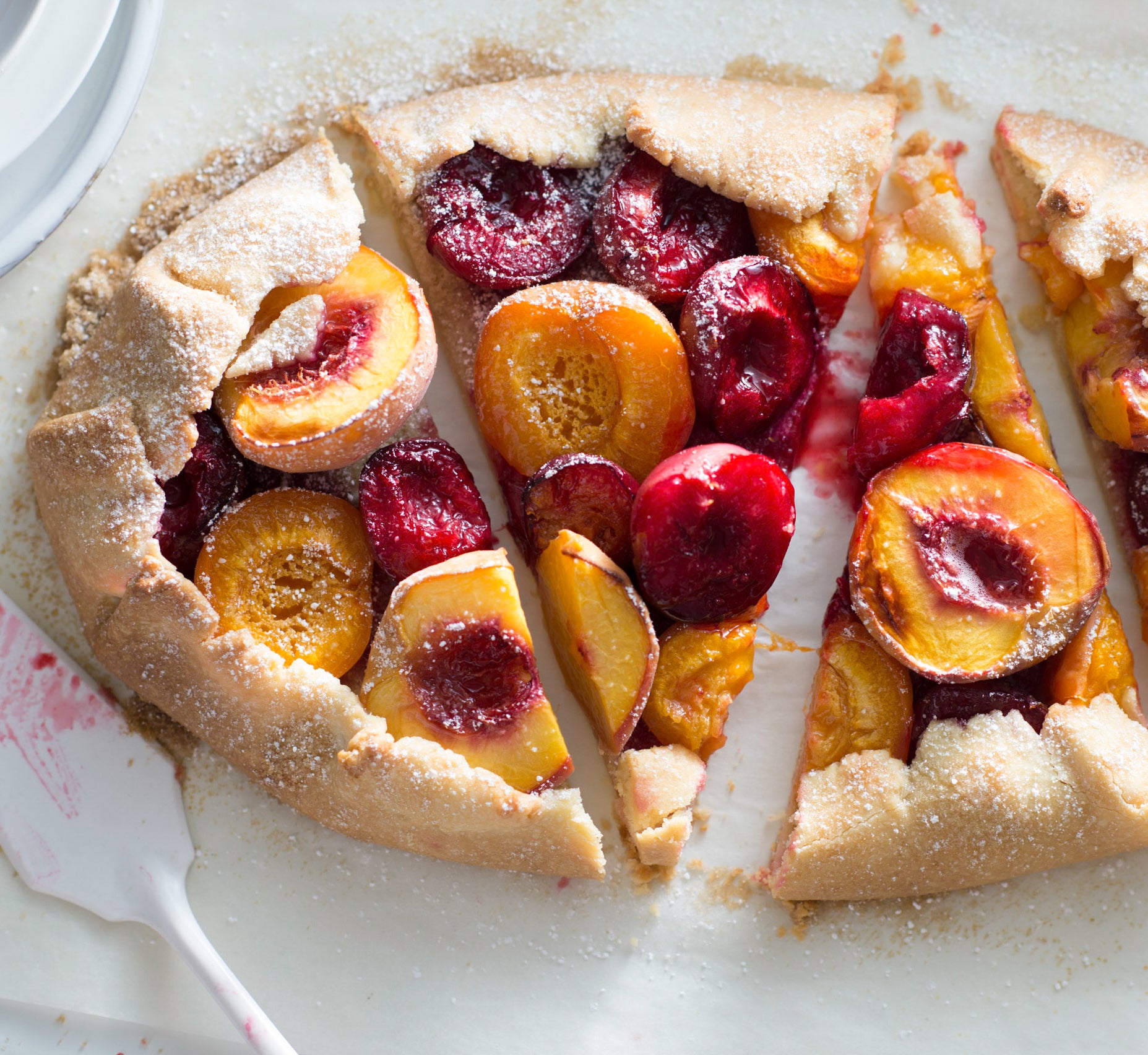
Prep 25min(+ pastry making and chilling time)Bake 50-55minMakes 8-10 serves
This tart is simplicity at its best – a selection of gorgeous summer stone fruit encased in a sweet, easy-peasy pastry. There's no real structure, it's slightly rustic and lets seasonal stone fruits shine. Serve with toffee ice-cream if you can – the combination is sublime.
Ingredients
1 quantity of Sweet Shortcrust Pastry (see Variations)
25g (¼ cup/¾oz) almond meal
700g (1lb 8oz) firm but ripe stone fruit of your choice (such as peaches, nectarines, plums and apricots), halved and pitted
2 tablespoons raw sugar
Icing sugar, to dust (optional)
Good-quality toffee or vanilla ice-cream, to serve
Method
- Preheat oven to 200°C/400°F (180°C/350°F fan-forced).
- Use a lightly floured rolling pin to roll out the pastry on a piece of non-stick baking paper to a rough rectangle about 3mm/⅛in thick. Use the paper to transfer the pastry to a large baking tray. Sprinkle the pastry with the almond meal, leaving a 5cm/2in-wide border around the edge. Arrange the fruit over the almond meal and then fold the pastry border up over the fruit. Sprinkle the upturned border and fruit with the sugar. Bake in preheated oven for 50-55 minutes or until the pastry is golden and crisp.
- Serve warm or at room temperature, dusted with icing sugar, if desired, cut into wedges and accompanied by ice-cream.
Baker's Tip
- This tart is best served warm, but is also great served at room temperature. It will keep covered in the fridge for up to 2 days. Stand at room temperature for about 30 minutes before serving.
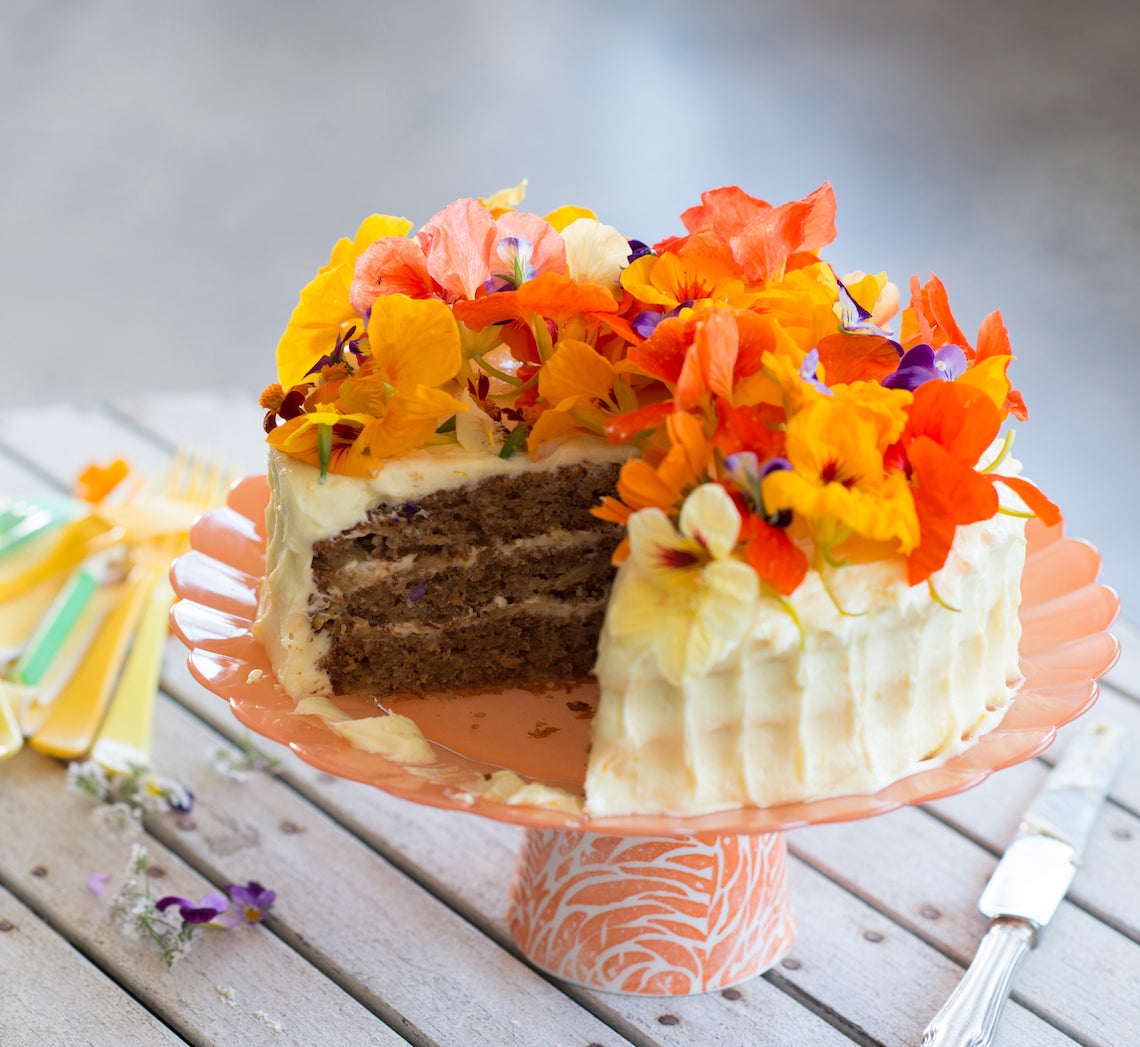
Prep 30minBake 30-35minMakes 12-15 serves
Originating (and excessively popular) in America, Hummingbird cake is a tropical mix of banana and pineapple, and when layered with an orange cream cheese frosting makes a great celebration cake. Sweet and indulgent, a small slice is all that is needed to satisfy.
Ingredients
150g (1 cup) plain flour
75g (½ cup) self-raising flour
½ teaspoon bicarbonate of soda
2 teaspoons ground cinnamon
220g (1 cup, firmly packed) brown sugar
45g (½ cup) desiccated coconut
2 very ripe large bananas (about 250g each)
440g crushed pineapple in natural juice, drained and juice reserved
2 eggs, lightly whisked
185ml (¾ cup) sunflower oil, plus extra to grease
Orange cream cheese frosting
100g unsalted butter, at room temperature
250g cream cheese, at room temperature
1 orange, zest finely grated
375g (3 cups) icing sugar mixture, sifted
Method
- Preheat oven to 180°C (160°C fan-forced). Brush three 20cm round cake tins with extra sunflower oil to lightly grease and line the bases with non-stick baking paper.
- Sift together the plain and self-raising flours, bicarbonate of soda and cinnamon. Add the brown sugar and coconut and stir to combine, breaking up any lumps.
- Mash the banana and combine with the drained pineapple, 80 ml (⅓ cup) of the reserved pineapple syrup, eggs and oil. Add to the flour mixture and use a wooden spoon or spatula to mix until just combined.
- Divide the mixture evenly among the prepared tins and spread with the back of a metal spoon to smooth the surface. Bake in preheated oven for 30-35 minutes or until cooked when tested with a skewer.
- Stand the cakes in the tins for 5 minutes before turning onto wire racks to cool (this will take about 1 hour).
- Meanwhile, to make the Orange cream cheese frosting, use an electric mixer to beat the cream cheese, butter and orange zest until very smooth. Gradually add the icing sugar, beating well after each addition and beat until well combined and really creamy. Divide the Orange cream cheese frosting evenly among 3 bowls.
- Take one portion of the Orange cream cheese frosting and use a palette knife to spread half over one cake layer. Top with a second cake layer and spread with the remaining frosting of the first portion. Top with the remaining cake layer. Spread another portion of frosting over the sides and the remaining portion over the top of the cake. Sprinkle with the pecans to decorate
Baker's Tips
- This cake will keep in an airtight container in the fridge for up to 4 days. Stand at room temperature for about 30 minutes before serving.
This recipe is from Anneka's SBS Food online column, Bakeproof: Cakes for Crowds. CLICK HERE for more Bakeproof recipes.
Photography by Alan Benson.
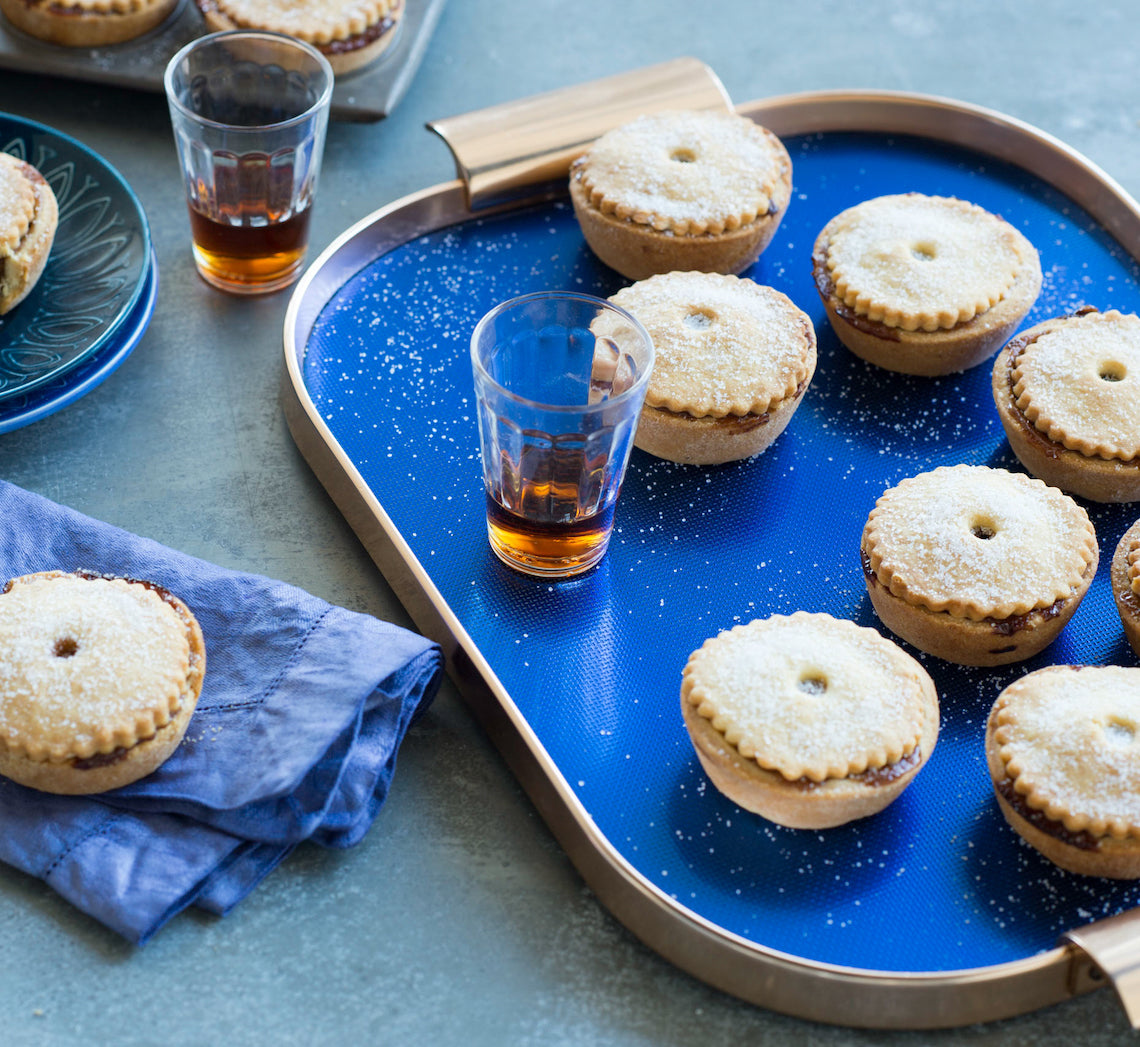
Prep 50min (+20min chilling and 50min cooling time)Bake 35minMakes about 20
According to a Middle Ages custom, if you eat a mince pie every day from Christmas day until Twelfth Night (6 January) you will have happiness for the whole year – what a wonderful excuse to indulge in these spiced, fruit-filled pies. Eat them at room temperature or straight from the oven with ice-cream, cream or brandy sauce.
You will need two 12-hole 80 ml (⅓ cup) muffin tins for this recipe.
Ingredients
Granulated sugar, to sprinkle
Fruit mince
2 small (about 150g each) Granny Smith apples, peeled, cored and coarsely grated
130 g (¾ cup) sultanas
115g (¾ cup) currants
130g (¾ cup) seedless raisins
75g (½ cup) mixed peel or chopped glace apricots
50g (⅓ cup) chopped blanched almonds
125ml (½ cup) brandy or apple cider
1 orange, zest finely grated and juiced
1 lemon, zest finely grated and juiced
2 teaspoons mixed spice
½ teaspoon ground ginger
¼ teaspoon ground cloves
100g (½ cup, loosely packed) dark brown sugar
60g unsalted butter, coarsely grated
Sweet shortcrust pastry
600g (4 cups) plain flour
125g (1 cup) icing sugar, sifted
1 teaspoon baking powder
½ teaspoon salt
300g chilled unsalted butter, diced
2 egg yolks
80-100ml iced water
Method
- To make the fruit mince, combine the grated apple, dried fruit, mixed peel, almonds, brandy or cider, orange and lemon zest and juice, and the spices in a medium saucepan. Cook over low heat, stirring occasionally for 20 minutes or until the excess liquid has evaporated. Remove from heat and set aside for 40 minutes or until cooled to room temperature.
- Meanwhile, to make the pastry, place the flour, icing sugar, baking powder and salt in a medium mixing bowl. Add the chilled butter. With your palms facing upwards, use your fingertips to rub in the butter until the mixture resembles coarse breadcrumbs. Use a fork to whisk together the egg yolks and 80 ml (⅓ cup) of the iced water and then sprinkle over the flour and butter mixture. Use a round-bladed knife in a cutting motion to mix until evenly combined and the mixture starts holding together. Press a little of the mixture between your fingers: if it holds together easily, there is no need to add more water. If it doesn’t, add the remaining 1 tbsp (20 ml) water and combine. The pastry should be soft but not sticky. Bring the pastry together with your hands and transfer to a lightly floured, cool bench top. Lightly knead the pastry with your fingertips for about 30 seconds or until smooth and soft. Divide pastry into three portions. Shape each into a disc, wrap separately in plastic wrap and place in the fridge for 20 minutes to rest.
- Preheat oven to 190°C (170°C fan-forced). Stir the sugar and butter through the cooled fruit mince.
- Use a lightly floured rolling pin to roll out one portion of the pastry to 3 mm thick. Use a 9 cm plain round cutter to cut out 10 rounds, re-rolling the offcuts if needed and line 10 x 80ml (⅓ cup) muffin tin holes, pressing into the sides and base with your fingertips (the pastry won’t reach to the top of the holes). Repeat with another portion of pastry to make another 10 pastry shells. Divide the fruit mince evenly among the pastry shells. Roll out the remaining pastry portion until 5 mm thick and use a 6.5 cm fluted round cutter to make the pie tops, re-rolling the off-cuts if needed. Use the end of a 7 mm piping nozzle to cut out a circle in the centre of each lid. Place a lid on top of each pie, and use your fingertips to gently ease the pastry out to meet the pastry case bases. Sprinkle each pie with a little granulated sugar.
- Bake in preheated oven for 35 minutes or until the pastry is deep golden and cooked through. Remove from the oven and stand in the tin for 10 minutes to cool slightly before transferring to a wire rack. Serve warm or at room temperature. Sprinkle with a little more granulated sugar, if desired.
Baker's Tips
- These pies will keep in an airtight container at room temperature for up to 1 week.
- To reheat, place the pies back in the muffin holes and place in an oven preheated to 170°C (150°C fan-forced) for 10-15 minutes or until heated through.
This recipe is from Anneka's SBS Food online column, Bakeproof: Traditional Christmas Baking. CLICK HERE for more Bakeproof recipes.
Photography by Alan Benson.

Prep 40min (+ 30min cooling time)Bake 25-30minMakes about 24
Originating in Vienna, Austria, these vanilla sugar-coated biscuits are traditionally shaped like a ‘kipfler’ or horseshoe. While they’re a Christmas favourite, they’re also popular across Eastern Europe – including Germany, Hungary, Slovakia, Romania and the Czech Republic – and closely resemble the well-known Greek Kourabiedes. Buttery and almond-rich, they make a lovely gift.
Ingredients
185g (6½oz) unsalted butter
60g (½ cup/2oz) icing sugar mixture, plus 60g (½ cup/2oz) extra to coat
1 teaspoon natural vanilla essence, extract or bean paste
2 egg yolks
225g (1½ cups/8oz) plain flour
50g (½ cup/1¾oz) almond meal
1 vanilla bean
Method
- Preheat oven to 160°C/315°F (140°C/285°F). Line two large oven trays with non-stick baking paper.
- Use an electric mixer to beat the butter, icing sugar mixture and vanilla until pale and creamy. Add the egg yolks and beat until well combined.
- Combine the flour and almond meal, add to the butter mixture and beat on lowest possible speed until just combined and a dough forms.
- Shape level tablespoonfuls of the mixture into small logs about 6cm ( 2¼in) long and then taper the ends and shape into a crescent shape. Place on the lined trays about 2cm ( ¾in) apart. Bake in preheated oven for 25-30 minutes or until pale golden and cooked through.
- Meanwhile, halve the vanilla bean lengthways, use a small sharp knife to scrape the seeds out and add to the extra icing sugar mixture in a medium bowl. Use your fingertips to rub the vanilla seeds through the icing sugar evenly.
- When the biscuits are cooked, remove from the oven and then toss while still warm, one at a time, through the vanilla icing sugar to coat (see Baker’s Tips). Cool completely on a wire rack.
Baker's Tips
- These biscuits will keep in an airtight container at room temperature for up to 1 week.
- Reserve any remaining vanilla sugar and use to sprinkle over the biscuits just before serving if you wish.
This recipe is from Anneka's SBS Food online column, Bakeproof: Traditional Christmas Baking.
CLICK HERE for more Bakeproof recipes.
Photography by Alan Benson.
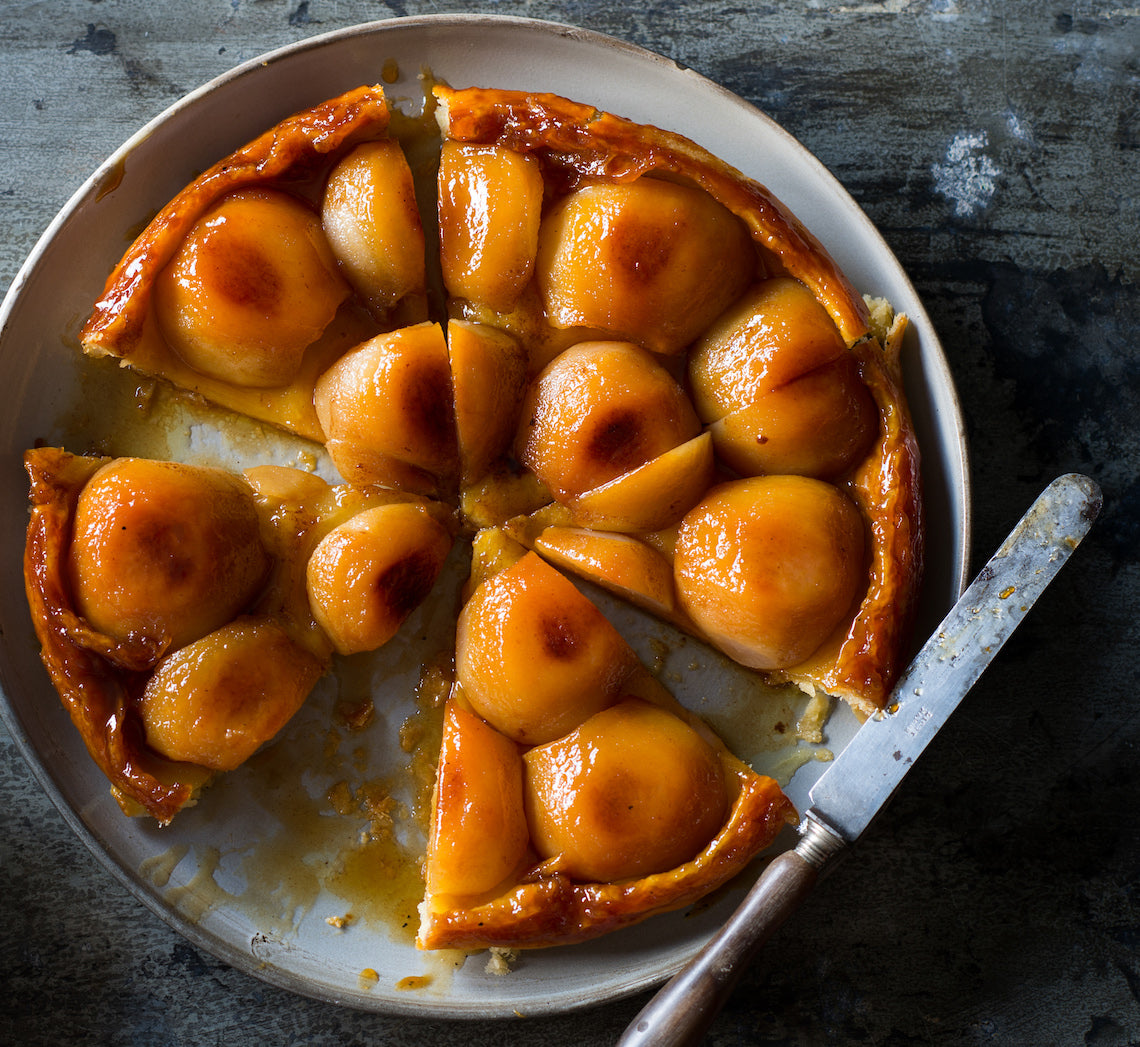
Prep 40min (+20min chilling and 1hr 25min cooling time)Bake 45minMakes 8 serves
Traditionally made with apples, this classic upside-down French tart was created by the Tatin sisters who ran a hotel in France in the early 1900s. If you don't have an ovenproof frying pan, transfer the cooled caramel and pears to a base-lined 22cm round cake tin before covering them with the pastry and baking.
Ingredients
Ground cinnamon, to sprinkle
Vanilla ice-cream, cream or crème fraiche, to serve
1 quantity Shortcrust Pastry
80g (2¾oz) salted butter, cubed
110g (½ cup/4oz) caster sugar
1.1kg (2lb 7oz) small (about 7) pears (such as Josephine), peeled, halved and cored
Method
- Prepare the Shortcrust Pastry.
- Meanwhile, melt the butter in a 20–22cm/8-8¼in(base measurement) heavy-based frypan over medium-high heat. Sprinkle with the sugar and then arrange the pears, cut-side up, in the pan, cutting some of the halves into quarters to fill the gaps. Reduce the heat to medium and cook, uncovered, for 15 minutes or until the liquid becomes a dark caramel and the pears are almost tender and golden underneath. Remove the pan from the heat and set aside for 1 hour 15 minutes or until cooled completely.
- Preheat oven to 190°C/375°F (170°C/340°F fan-forced).
- Use a lightly floured rolling pin to roll the pastry out on a lightly floured bench top to about 5mm/¼in thick and then cut into a circle about 26cm/10½in in diameter. Place the pastry over the cooled pears in the pan and carefully tuck the pastry edge around the fruit and down the side of the pan. Bake in preheated oven for 45 minutes or until the pastry is deep golden and cooked through and the pear juices are bubbling. Remove from the oven and set aside for 10 minutes to cool slightly.
- Place a serving plate with a lip over the top of the tart and invert. Serve immediately cut into wedges and accompanied by ice-cream, cream or crème fraiche.
This recipe is from Anneka's SBS Food online column, The real secrets of French baking.
CLICK HERE for more Bakeproof recipes.
Photography by Alan Benson.
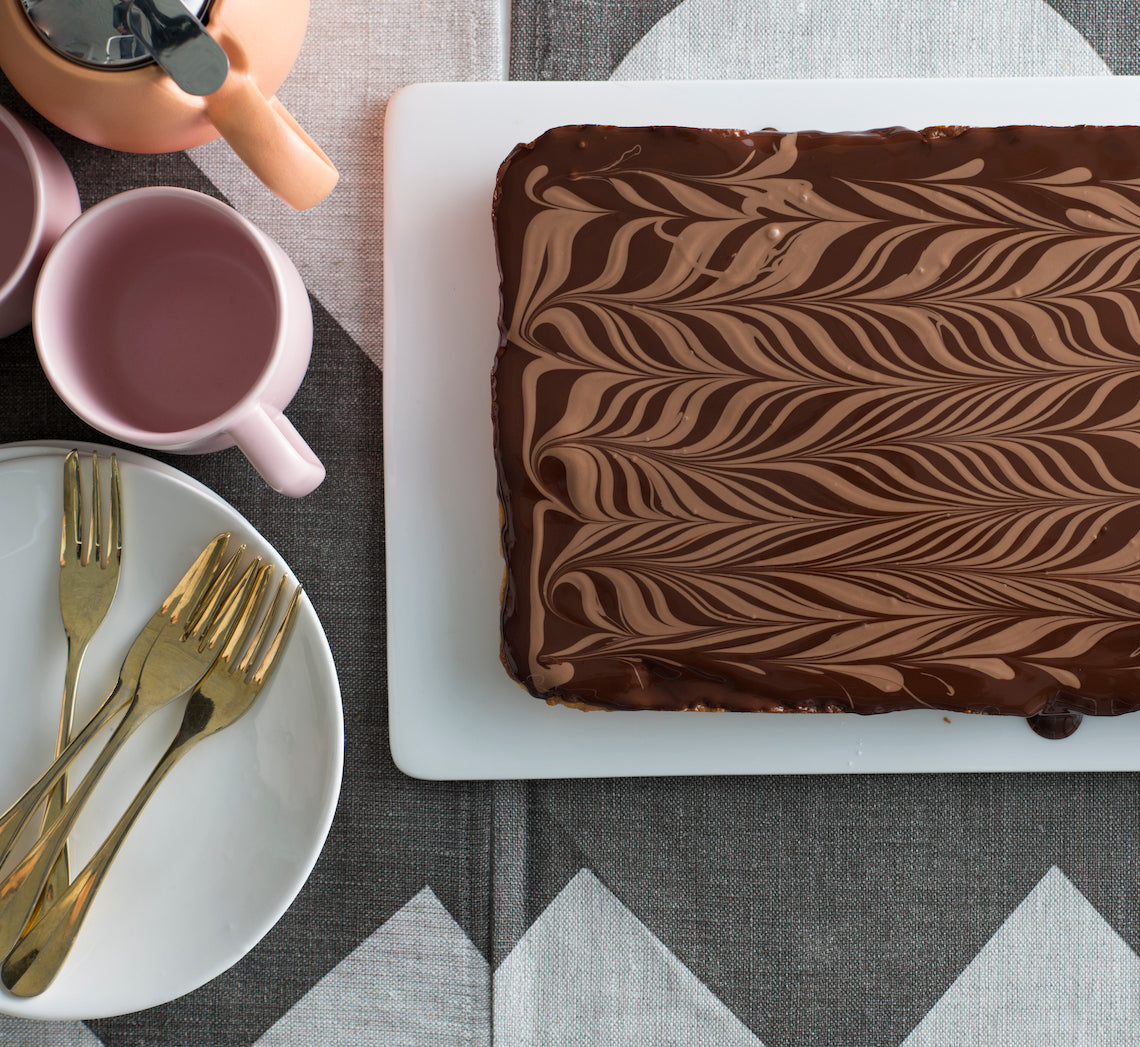
Prep 30min (+1hr cooling and 1hr chilling time)Bake 20minMakes 20 pieces
This has to be the perennial favourite... biscuit base, gooey caramel centre and chocolate topping is a combination made in heaven. This chocolate caramel slice has been given a little makeover with a feather-patterned topping.
Ingredients
110g (¾ cup/4oz) plain flour
½ teaspoon baking powder
30g (⅓ cup/1oz) desiccated coconut
75g (⅓ cup, firmly packed/2¾oz) brown sugar
80g (2¾oz) salted butter, melted
1 teaspoon natural vanilla essence or extract
Caramel filling
395g (13¼oz) tin sweetened condensed milk
110g (½ cup, firmly packed/4oz) brown sugar
1 tablespoon golden syrup
40g (1½oz) salted butter, cubed
Chocolate topping
200g (7oz) good-quality dark chocolate (70% cocoa), chopped
30g (1oz) salted butter, cubed
75g (2¾oz) good-quality milk chocolate
Method
- Preheat oven to 180°C/350°F (160°C/315°F fan-forced). Grease a 16cm x 26cm (6 ¼in x 10½in), base measurement, shallow slice tin and line the base and sides with one piece of non-stick baking paper, cutting into the corners to fit.
- To make the base, combine the flour, baking powder, desiccated coconut and brown sugar in a medium bowl. Add the butter and vanilla and mix well. Crumble evenly over the base of the lined tin and use your hands to press down firmly and cover evenly. Bake in preheated oven for 12-15 minutes or until cooked through and lightly golden. Remove from the oven.
- Meanwhile, to make the Caramel Filling, combine the sweetened condensed milk, brown sugar, golden syrup and butter in a small saucepan and cook over a low heat, stirring constantly, for 10 minutes, or until the sugar dissolves and the mixture thickens slightly (do not boil).
- Pour the hot caramel immediately over the base and use the back of a metal spoon to smooth the surface. Return the slice to the oven and bake for 10 minutes or until the caramel has darkened slightly and starts to bubble around the edges. Remove from the oven and set aside for 1 hour or until cooled completely.
- To make the Chocolate Topping, combine the dark chocolate and butter in a medium heatproof bowl over a saucepan of simmering water (don’t let the water touch the base of the bowl). Stir frequently until the chocolate melts and the mixture is smooth. Pour over the cooled slice and use the back of a metal spoon to cover evenly. Tap the tin on the bench to even the topping and to remove any air bubbles. Melt the milk chocolate in the same way as the dark chocolate and butter in a separate small heatproof bowl. Place the slice with a short side of the tin closest to you. Use a teaspoon to generously drizzle the milk chocolate widthways across the dark chocolate to form horizontal lines. Then use a skewer to run through both the dark and milk chocolate lengthways 5-6 times in alternate directions to form a feather pattern. Place in the fridge for 1 hour or until the chocolate sets.
- Use a warm large sharp knife to cut into pieces to serve.
Baker's Tip
- This slice will keep in an airtight container in the fridge for up to 1 week.
This recipe is from Anneka's SBS Food online column, Bakeproof: Childhood Favourites.
CLICK HERE for more Bakeproof recipes.
Photography by Alan Benson.

Prep 40min (+30min chilling and 30min cooling time)Bake 20minMakes 12
Dating back almost a century, this Australian creation of a pastry case filled with mock cream (and sometimes a raspberry jam layer) and topped with sickly sweet icing seems to hit a nostalgic chord – we all remember eating them as a child! For a more contemporary twist, we've added an extra colour punch to the pink icing. Remember that chocolate and white, or pink and white are also popular colour combinations.
Ingredients
1 quantity Sweet shortcrust pastry, divided in half before wrapping and chilling as directed
Mock Cream Filling
1 tablespoon boiling water
½ teaspoon gelatine powder
65g (⅓ cup) caster sugar
2 tablespoons milk
125g unsalted butter, softened
1 teaspoon natural vanilla essence or extract
Icing
185g (1½ cups) pure icing sugar
1 tablespoon water, plus 1 teaspoon extra (optional)
2 teaspoons sifted cocoa powder
Pink food colouring
Method
- Unwrap one pastry portion and place on a lightly floured, cool work surface. Gently pat the pastry with the palm of your hand to flatten slightly. Use a lightly floured rolling pin to roll out on a lightly floured surface until 3mm thick. Use an 8cm diameter plain round cutter to cut out 6 circles, re-rolling the pastry if necessary. Line six holes of a 12-hole 80ml ( ⅓ cup) muffin tin (the pastry circles won’t fill the muffin holes completely. Repeat with the remaining pastry portion to line the six remaining muffin holes.
- Prick each pastry case base 3 times with a fork and place in the fridge for 30 minutes. Preheat the oven to 200°C (180°C fan-forced).
- Line each tartlet case with a piece of foil and then fill with dried rice. Blind bake the tart cases for 15 minutes or until the pastry is sealed. Use the foil to lift the rice out of the tartlet cases and bake for a further 5 minutes or until lightly golden and cooked through. Cool the cases in the tin.
- To make the Mock cream filling, put the boiling water in a small ramekin and sprinkle the gelatine over the top. Use a fork to whisk the gelatine into the water and then set aside for about 3 minutes or until the mixture is clear (see Bakers Tips). Meanwhile, combine the sugar and milk in a small saucepan and stir over medium heat until the sugar dissolves. Stir in the gelatine mixture until well combined. Remove from heat and set aside, stirring occasionally so the gelatine doesn't set, for 30 minutes or until cooled to room temperature.
- Use an electric beater to beat the butter and vanilla in a medium bowl until pale and creamy. With the motor running, gradually add the cooled gelatin mixture in a slow steady stream until well combined and fluffy. Divide the Mock cream filling evenly among the pastry cases and smooth the surfaces. Set aside in a cool spot but not in the fridge.
- To make the Icing, sift the icing sugar into a bowl and then stir in the water until smooth (the icing should be a spreadable consistency). Put half the icing into a separate bowl and stir in the cocoa powder and extra teaspoon of water. Colour the remaining portion with 2-4 drops of pink food colouring. Use a palette knife or the back of a teaspoon to spread about a teaspoon of the pink icing over the top of half of each tart. Set aside for 5-10 minutes for the icing to set. Spread about a teaspoon of the chocolate icing over the remaining half of each tart to cover the tops and then set aside for 5-10 minutes for the icing to set. Serve at room temperature.
Baker's Tips
- If the gelatine doesn't dissolve in the boiling water and become clear, add boiling water to a larger heatproof bowl, jug or dish and then sit the ramekin with the gelatine mixture in the water. Stir occasionally until the mixture is clear.
- These tarts will keep in an airtight container in the fridge for up to 4 days. Serve at room temperature.
This recipe is from Anneka's SBS Food online column, Bakeproof: Childhood Favourites. CLICK HERE for more Bakeproof recipes.
Photography by Alan Benson.
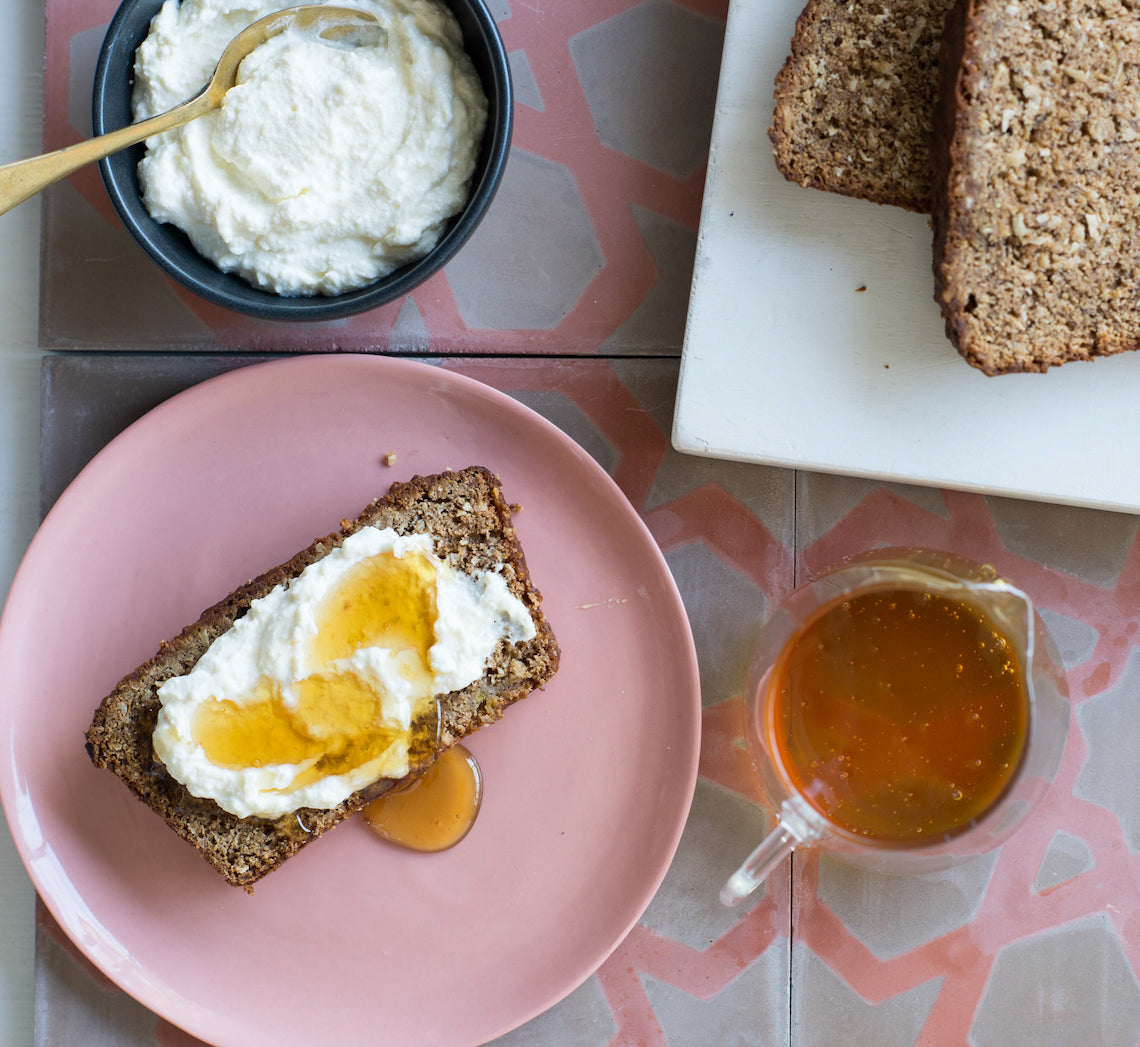
Prep 15minBake 50minMakes 12 serves
This banana bread is heaven. The addition of coconut oil adds a wonderful richness and heavenly aroma that you won’t be able to resist. This loaf also keeps well and becomes more moist and flavoursome with time, so try not to eat it all at once! It's wonderful served on its own or toasted and spread with butter or ricotta and drizzled with honey.
Ingredients
Melted coconut oil, to grease240g (1½ cups) wholemeal spelt flour
1 teaspoon baking powder
1 teaspoon bicarbonate of soda
70g (1 cup) shredded coconut
100g (½ cup) coconut oil, at room temperature
180g (1 cup) coconut palm sugar
1 egg
2 large (about 200g each) very ripe bananas
130g (½ cup) Greek-style natural yoghurt
Method
- Preheat oven to 180°C (160°C fan-forced). Grease a 21 x 10.5cm (base measurement) loaf pan with the melted coconut oil and line the base and two long sides with one piece of non-stick baking paper.
- Sift together the flour, baking powder and bicarbonate of soda into a large bowl, returning any husks to the flour mixture. Stir in the coconut.
- Use an electric mixer to beat the coconut oil and sugar in a mixing bowl until well combined (it will look like wet sand). Add the egg and beat well, scraping down the sides of the bowl if necessary. Mash the bananas, add to the coconut mixture with the yoghurt and beat until well combined. Add the dry ingredients and beat on low speed until just combined.
- Pour the mixture into the prepared tin. Use the back of a spoon to smooth the surface and then tap the tin lightly on the benchtop to settle the mixture. Bake in preheated oven for 45-50 minutes or until golden brown and a skewer inserted into the centre comes out clean. Stand in the tin for 5 minutes before turning onto a wire rack to cool. Serve in slices.
Baker's Tips
- This banana bread will keep in an airtight container at room temperature for up to 4 days.
This recipe is from Anneka's SBS Food online column, Bakeproof: Coconut.
CLICK HERE for more Bakeproof recipes.
Photography by Alan Benson.
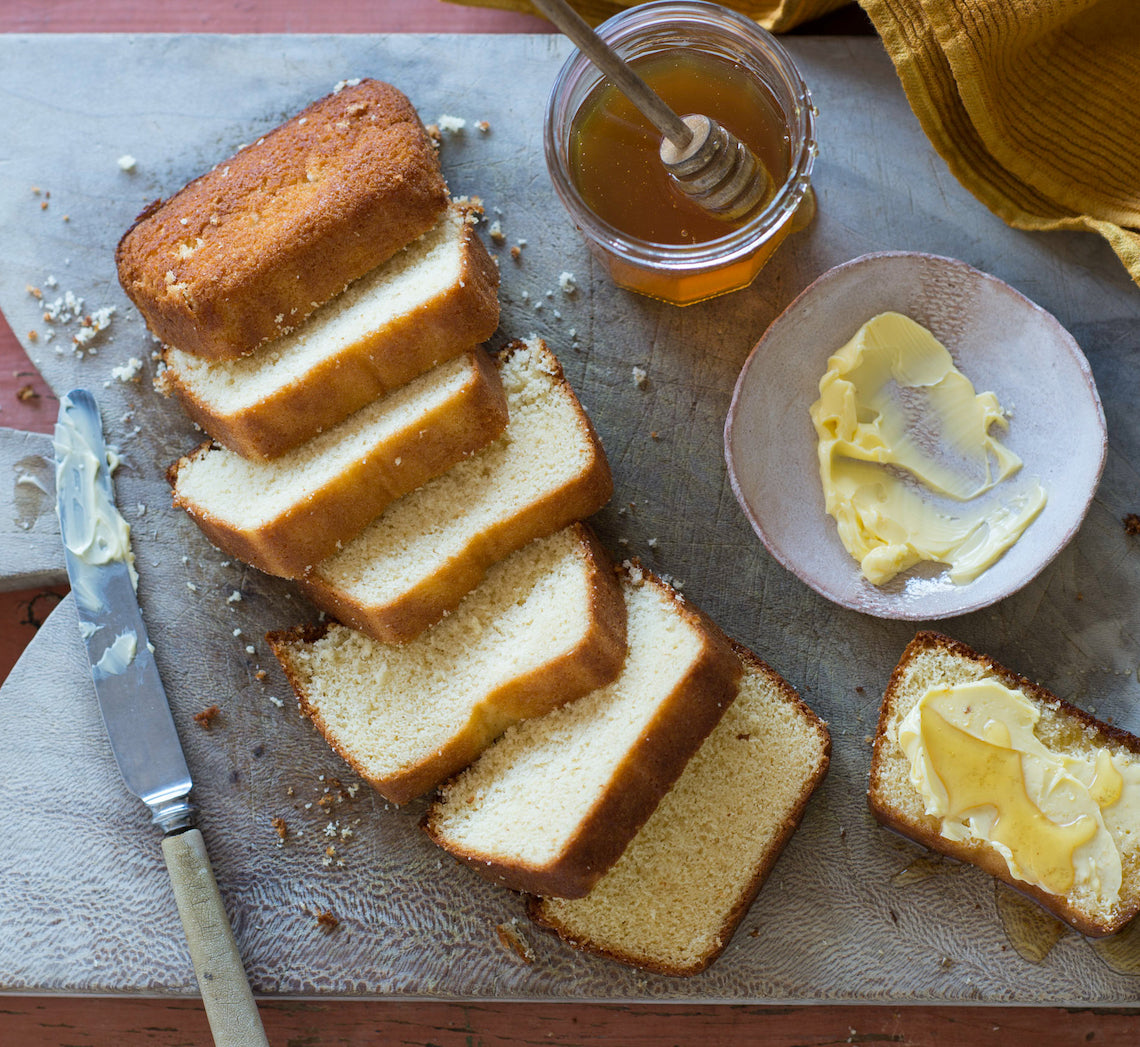
Prep 20min (+overnight chilling time)Bake 30minMakes 2 loaves
A specialty of the Nagasaki area in Japan, this wonderfully simple, honey-scented sponge cake was originally introduced by the Portuguese merchants in the 16th century, with its name originating from Pão de Castela meaning "bread from Castile". This cake defies sponge logic – strong bread flour gives it a "bouncy" texture, but it's still particularly moist and delicate, and becomes more so with time. Don’t be tempted to eat it straight from the oven (believe me, the heavenly honey aromas will tempt you!) – it needs to be wrapped while still warm and kept in the fridge overnight for its texture to be transformed.
Ingredients
- 6 eggs, at room temperature
- 220g (1 cup) caster sugar
- 115g (⅓ cup) honey
- 2 tablespoons warm water
- 200g (1¼ cups) bread flour, sifted twice
- Butter and extra honey, to serve
Honey Glaze
- 1 tablespoon honey
- 2 teaspoons warm water
Method
- Preheat oven to 180°C. Grease two 9 x 19cm (base measurement) loaf pans with butter and line each with two strips of baking paper.
- Use an electric mixer with a whisk attachment to whisk the eggs until frothy. Add the sugar and whisk on medium speed for 6-8 minutes or until the mixture is very thick and pale, has increased by four times its volume and a ribbon trail forms when the whisk is lifted.
- Add the combined honey and water and whisk until just combined.
- Add a third of the twice-sifted bread flour to the egg mixture and whisk on low speed for about 15 seconds or until just combined. Add the remaining flour in two separate batches, whisking on low until just combined as with the first batch, and checking that no flour has been caught in the bottom of the bowl.
- Divide the mixture evenly between the two prepared tins. Bake in preheated oven for 30 minutes or until a skewer inserted into the center comes out clean and the cakes will feel spongy when pressed in the center.
- To make the Honey Glaze, combine the honey and water in a small bowl and stir to combine. Brush the tops of the cakes with the Honey Glaze. Lay two pieces of plastic wrap large enough to wrap each cake on the bench top and turn the hot cakes out directly onto them. Wrap the cakes in the plastic wrap (this will help them retain their moisture), place on a tray, top side down, and put in the fridge, for at least 12 hours or overnight.
- Bring the cake to room temperature before serving in slices on its own or with butter and extra honey, if desired.
Baker's Tips
- This cake will keep at room temperature in an airtight container for up to 5 days.
This recipe is from Anneka's SBS Food online column, Bakeproof: Sponge Cake.
CLICK HERE for more Bakeproof recipes.
Photography by Alan Benson.
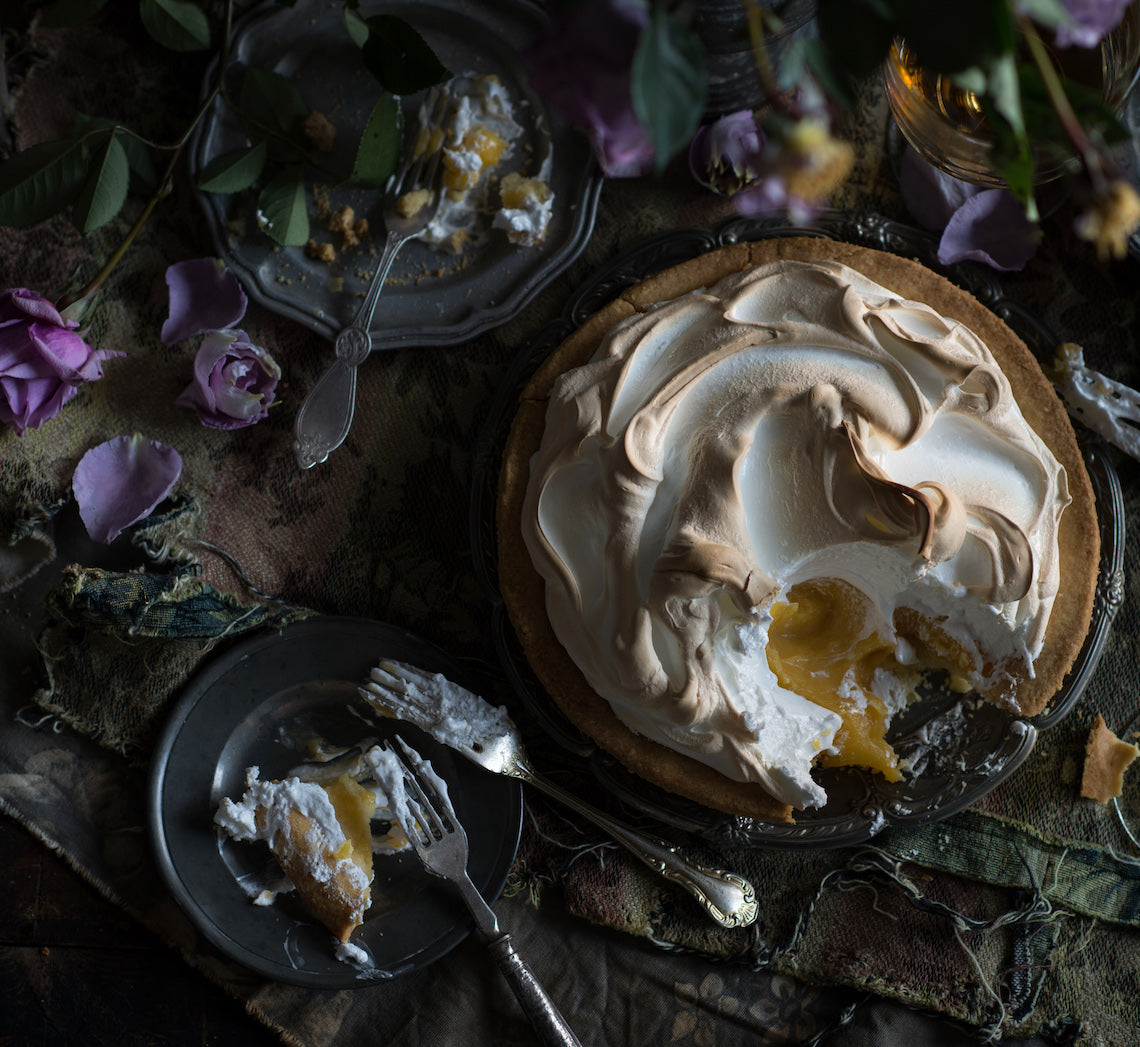
Prep 40min (+pastry making, 30min cooling and 2hr chilling time)
Bake 45-55minMakes 8-10 serves
Sometimes known as lemon chester pudding, lemon meringue pie is a wonderful combination of short, buttery pastry, a tart custard filling and a sweet, fluffy meringue topping. This recipe won’t disappoint!
Ingredients
1 quantity sweet shortcrust pastry, shaped into a disc before wrapping and chilling
Lemon Filling
40g (⅓ cup) cornflour, sifted
200ml strained freshly squeezed lemon juice
80ml (⅓ cup) water
220g (1 cup) caster sugar
6 egg yolks
100g salted butter, diced
Italian Meringue Topping
4 egg whites
220g (1 cup) caster sugar
80ml (1/3 cup) water
Pinch of salt
Method
- Preheat oven to 200°C (180°C fan-forced).
- Use a lightly floured rolling pin to roll out the pastry on a lightly floured bench top to a round about 3mm thick. Line an ungreased 22cm diameter (base measurement), 3cm deep pie plate or tart tin with the pastry. Use a small sharp knife to trim any excess pastry.
- Place the pastry case on an oven tray and use a fork to prick the base about 12 times. Line the pastry case with crumpled baking paper or foil and fill with pastry weights or raw rice, making sure they fill the case. Bake in preheated oven for 20 minutes.
- Remove the pastry case from the oven and use the paper or the foil to lift the weights out of the case. Return the case to the oven and bake for a further 20-25 minutes or until the pastry is cooked through and is golden. Set aside to cool.
- To make the Lemon Filling, place the cornflour in a medium saucepan. Use a balloon whisk to gradually stir in the combined lemon juice and water until smooth and well combined. Stir in the sugar, egg yolks and butter. Stir over medium heat for 3-5 minutes or until the butter melts. Continue to stir over medium-low heat for 5-10 minutes or until the mixture thickens and comes to a simmer. Pour immediately into the pastry shell and use the back of a metal spoon to smooth the surface. Set aside for 30 minutes to cool. Cover and chill for at least 2 hours or until the filling is set.
- When ready to serve, preheat oven to 240°C (220°C fan-forced).
- To make the Italian Meringue Topping, put the egg whites in the bowl of a stand mixer fitted with a whisk attachment. Combine the sugar and water in a small saucepan and stir with a wooden spoon or spatula over low heat until the sugar dissolves. Increase the heat to medium and bring to the boil. Boil for about 10 minutes, occasionally brushing down the side of the pan with a pastry brush dipped in water to dissolve any sugar crystals, until the syrup reaches soft ball stage (115°C on a sugar thermometer). Meanwhile, just before the syrup is ready, whisk the egg whites on high speed until firm peaks form. Remove the syrup from the heat and stand for about 1 minute or until the bubble subside. With the motor running on high speed, gradually add the sugar syrup in a thin steady stream until all the syrup has been incorporated. Add the salt and then continue to whisk on medium speed for another 10 minutes or until the meringue has cooled to room temperature.
- Spread the meringue mixture over the top of the lemon filling, swirling as desired. Bake in preheated oven for 5-10 minutes or until browned on the edges (see Baker’s Tips). Stand for 5 minutes before scooping with a large metal spoon or cutting into wedges with a sharp knife that has been dipped in hot water (see Baker’s Tips).
Baker's Tips
- This pie is best eaten the day it is made.
- If using a tart tin, you can transfer the pastry case to a ovenproof serving plate before adding the filling.
- You can also use a blowtorch to caramelise the meringue topping instead of returning it to the oven in step 7.
- Dipping the spoon or knife in hot water and drying before scooping or cutting will make it easier to portion.
This recipe is from Anneka's SBS Food online column, Bakeproof: Citrus.
CLICK HERE for more Bakeproof recipes.
Photography by Alan Benson.






